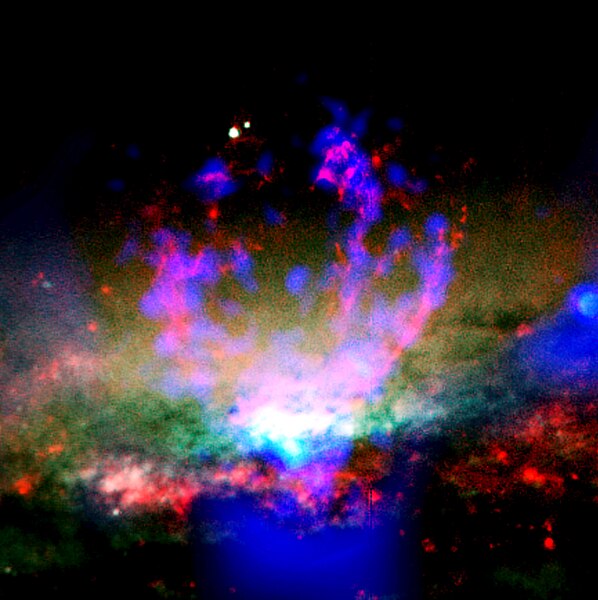File:NGC 3079 (A spiral galaxy about 55 million light years from Earth.) (2940658669).jpg

Original file (2,392 × 2,400 pixels, file size: 790 KB, MIME type: image/jpeg)
Captions
Captions
Summary edit
| DescriptionNGC 3079 (A spiral galaxy about 55 million light years from Earth.) (2940658669).jpg |
Description: Chandra's X-ray image (blue) combined with Hubble's optical image (red and green) reveal towering filaments of warm (about ten thousand degrees Celsius) and hot (about ten million degrees Celsius) gas that blend to create the bright horseshoe-shaped feature near the center. This feature is thought to have been formed when a superwind of hot gas collided with cold gas in the galactic disk. The full extent of the superwind shows up as a fainter conical cloud of X-ray emission surrounding the filaments. Superwinds originate in the centers of galaxies either from activity generated by supermassive black holes, or by bursts of supernova activity. Creator/Photographer: Chandra X-ray Observatory NASA's Chandra X-ray Observatory, which was launched and deployed by Space Shuttle Columbia on July 23, 1999, is the most sophisticated X-ray observatory built to date. The mirrors on Chandra are the largest, most precisely shaped and aligned, and smoothest mirrors ever constructed. Chandra is helping scientists better understand the hot, turbulent regions of space and answer fundamental questions about origin, evolution, and destiny of the Universe. The images Chandra makes are twenty-five times sharper than the best previous X-ray telescope. NASA's Marshall Space Flight Center in Huntsville, Ala., manages the Chandra program for NASA's Science Mission Directorate in Washington. The Smithsonian Astrophysical Observatory controls Chandra science and flight operations from the Chandra X-ray Center in Cambridge, Massachusetts. Medium: Chandra telescope x-ray Date: 2003 Repository: Smithsonian Astrophysical Observatory Gift line: NASA/CXC/STScI/U.North Carolina/G.Cecil Accession number: ngc3079 |
| Date | |
| Source | NGC 3079 (A spiral galaxy about 55 million light years from Earth.) |
| Author | Smithsonian Institution from United States |
| Permission (Reusing this file) |
Smithsonian Institution @ Flickr Commons |
Licensing edit
This image was taken from Flickr's The Commons. The uploading organization may have various reasons for determining that no known copyright restrictions exist, such as: No known copyright restrictionsNo restrictionshttps://www.flickr.com/commons/usage/false
More information can be found at https://flickr.com/commons/usage/. Please add additional copyright tags to this image if more specific information about copyright status can be determined. See Commons:Licensing for more information. |
| This image was originally posted to Flickr by Smithsonian Institution at https://flickr.com/photos/25053835@N03/2940658669. It was reviewed on 14 September 2016 by FlickreviewR and was confirmed to be licensed under the terms of the No known copyright restrictions. |
14 September 2016
File history
Click on a date/time to view the file as it appeared at that time.
| Date/Time | Thumbnail | Dimensions | User | Comment | |
|---|---|---|---|---|---|
| current | 07:35, 14 September 2016 |  | 2,392 × 2,400 (790 KB) | Vanished Account Byeznhpyxeuztibuo (talk | contribs) | Transferred from Flickr via Flickr2Commons |
You cannot overwrite this file.
File usage on Commons
There are no pages that use this file.
Metadata
This file contains additional information such as Exif metadata which may have been added by the digital camera, scanner, or software program used to create or digitize it. If the file has been modified from its original state, some details such as the timestamp may not fully reflect those of the original file. The timestamp is only as accurate as the clock in the camera, and it may be completely wrong.
| Image title |
|
|---|---|
| Author | Chandra X-ray Observatory Center |
| Copyright holder | http://chandra.harvard.edu/photo/image_use.html |
| Label | Review |
| Headline | A spiral galaxy about 55 million light years from Earth. |
| Credit/Provider | NASA/CXC/STScI/U.North Carolina/ |
| Source | Chandra X-ray Observatory |
| Online copyright statement | |
| Usage terms | |
| Date and time of data generation | 19 February 2003 |
| Width | 2,392 px |
| Height | 2,400 px |
| Bits per component |
|
| Compression scheme | LZW |
| Pixel composition | RGB |
| Orientation | Normal |
| Number of components | 3 |
| Horizontal resolution | 300 dpi |
| Vertical resolution | 300 dpi |
| Data arrangement | chunky format |
| Software used | Adobe Photoshop CS3 Macintosh |
| File change date and time | 18:33, 8 October 2008 |
| Color space | Uncalibrated |
| Image width | 2,392 px |
| Image height | 2,400 px |
| Exif version | 2.21 |
| Date and time of digitizing | 14:33, 8 October 2008 |
| Date metadata was last modified | 14:39, 8 October 2008 |
| Keywords | NGC 3079 |
| Contact information | cxcpub@cfa.harvard.edu
60 Garden St. Cambridge, MA, 02138 USA |
| IIM version | 2 |